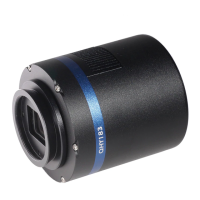
Do you have a question about the QHYCCD QHY183 and is the answer not in the manual?
| Brand | QHYCCD |
|---|---|
| Model | QHY183 |
| Category | Camera Accessories |
| Language | English |
Definition and importance of back focus distance for acquiring a sharp image.
Guidance on achieving optimal back focus distance, considering optical structure and focusers.
Explanation of external (M) and internal (F) thread designations and examples.
Using the camera as an eyepiece, basic connection is sufficient for EAA.
Using fine adjustment adapters to meet strict optimal back focus distance (OBFD) requirements.
Using CFW2 or CFW3 directly threaded onto the camera without extra adapters.
Using adapter 020063 for less back focus and reduced tilt.
Recommended connection for small sized cameras using OAGS with specific back focus.
Recommended connection for small sized cameras using OAGM with specific back focus.
Connecting CFW S with OAGS, noting DSLR lens incompatibility.
Connecting CFW M with OAGM, noting DSLR lens incompatibility.
Basic connection for medium sized cameras to telescopes without correctors.
Installing UV/IR cut filters using adapters 020076 and 020077.
Using various adapters for medium sized cameras with flatteners to meet OBFD.
Connecting large filter wheel (CFWL) to QHY600M camera using screw mounting.
Matching medium sized cameras with medium sized OAGM for optimal connection.
Connecting CFWL and OAG to QHY600M, noting DSLR lens incompatibility.
